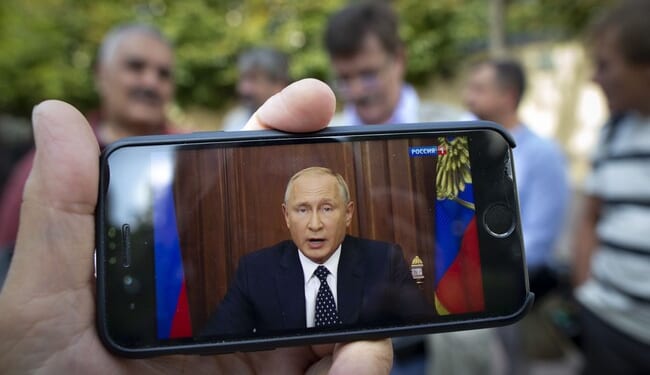
Like a led zeppelin, Russia’s population is falling fast.
In 2024, Russian births fell to a 25-year low, barely reaching 1.22 million. Calling it a “national threat,” the Kremlin has repeatedly tried offering incentives for having children: cash bonuses for new parents, abortion restrictions, and bans on “child-free propaganda” have failed to bend the curve.
Slogans can’t hide the hard truth: Too many people have died, too many women have left, and too few believe the future is worth having children for.
By the end of this decade, the labor ministry is forecasting a worker shortfall; nearly one-third of Russian citizens are already over 55, which places a spotlight on an aging, shrinking nation trying to wage a modern war that looks less like an empire and more like a hospice with missile launchers attached to walkers.
Europe’s Warning From a Century Ago
You would think Russia has already learned the lesson. Over one hundred years ago, Europe quickly learned the hard way how a population loss reshapes power.
France and Germany suffered demographic collapse after World War I: France lost nearly 1.4 million births on top of deaths on the battlefield, meaning the generation coming of age by 1939 was basically skeletal in size.
The workforce and tax base in Germany were also thinner, which forced political radicals to exploit resentment rather than pursue reform.
The lesson stuck: When a nation runs out of sons, it also runs out of options. A baby boom helped Western Europe rebound after 1945. For the Soviet Union?
Not so much.
Nearly 27 million Soviets died in the war; many of them were young men, the very age driving both recovery and reproduction, generating a scar that lasted decades.
While the West built suburbs, the East buried its youth and rebuilt its fear.
Purges, Famines, and the Long Shadow of State Violence
Even before Operation Barbarossa, Stalin’s terrible purges hollowed out the population. Millions were wiped out during the 1930s purges, the very same demographic capable of rebuilding afterward.
Next up were the gulags, political cleansing, and the quiet mass graves marking every decade of Soviet control. Each wave didn’t only erase entire families, but also family lines, creating what demographers call “missing generations.”
The Khmer Rouge in Cambodia repeated the same pattern in the 1970s, killing a quarter of its population, leaving behind a nation that limped for decades. Bosnia’s ethnic war in the 1990s killed over 100,000 and shattered its fertility rate.
When a government murders its own or drives them to flee, it’s not just destroying today, it’s bleeding tomorrow dry.
What Russia Is Trying, and Why It’s Failing
Looking more like a sermon than a strategy, Putin’s latest demographic revival included medals, subsidies, and patriotic slogans to solve the problem.
Doctors in some regions of Russia are being punished for “coercing abortions,” and state television praises the idea of a large family, calling it a “national duty.“
Despite the push, ordinary Russians offer the same reasons others do for having children: no money, no stability, and fathers returning home from the front. Nobody can raise children on decrees and propaganda.
You need peace, jobs, and most importantly, hope.
War Makes Every Trend Worse
The Russian/Ukraine war amplifies every weakness. Russian battlefield deaths are estimated to be more than 200,000, and have caused hundreds of thousands more men of draft age to flee to Kazakhstan, Georgia, and Europe in hopes of avoiding conscription.
Even if some decide to return, it will be to a home with a limping economy that’s coping with sanctions and labor shortages. A loss in Ukraine ripples through families, empty cribs, and unmanned factories.
No nation can fight two wars—one abroad and one against its own demographic clock—without losing one of them.
The Consequences for the West
We can’t assume that a shrinking Russia will become harmless. Young populations aren’t needed to use nuclear stockpiles and cyber weapons. History shows that insecure powers lash out when the decline becomes too big to hide.
Years of exhaustion and demographic stagnation followed the 1991 Soviet collapse; Putin’s Russia is facing a similar reckoning.
The proper response for the United States and its allies isn’t celebration; it’s steadiness: Keep pressure on sanctions, support Ukraine’s defenses, expand domestic energy production to blunt Moscow’s leverage, and, above all, stay patient.
Russia’s decline isn’t a sprint; it’s math.
And math, when it’s not acting racist, always wins.
Final Thoughts
Ideology doesn’t give two hoots about the math of decline, which only cares about life and death, and birth and absence. Europe learned that lesson after the First World War, when graveyards filled faster than nurseries.
The Soviet Union learned it under Lenin, then again under Stalin, and now, Putin is learning it firsthand. Here’s a simple equation that repeatedly gets lost over time: You can’t threaten a population into growing; you can only inspire it.
In Russia’s case, Putin has run out of inspiration.
Support Reporting that Follows the Numbers
If you value fact-driven commentary that cuts through propaganda and puts history beside headlines, join our VIP community.
You’ll get deeper dives into global trends that shape America’s future and columns that treat readers like adults, curious, skeptical, and sharp.
Use promo code FIGHT for a major discount, and help PJ Media keep truth at the top of the feed.









